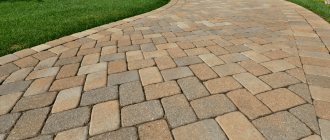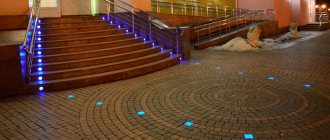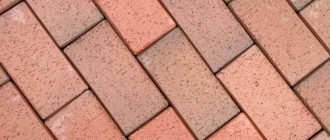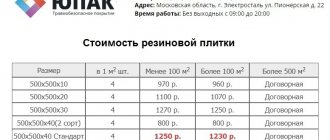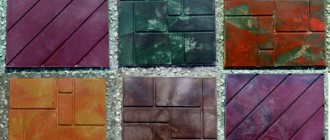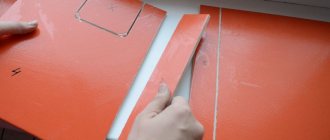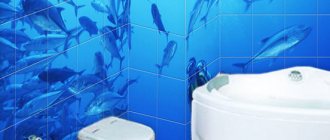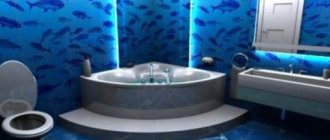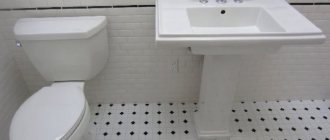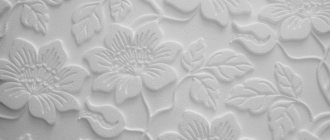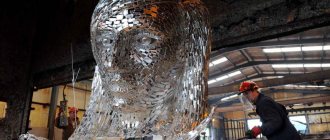The use of paving slabs in landscape design, design of a city pedestrian zone, local area, and recreation areas allows you to create a countless variety of road surface options.
It’s not surprising - the material is durable, strong, and wear-resistant. The variety of assortment (sizes, shapes, materials, colors) allows you to implement almost any idea for the design of the territory.
In addition to purely technical characteristics, not least important is the affordable price of paving slabs and the total cost of the entire coating in the complex.
In terms of price-quality ratio, consumers show the greatest practical interest in cement-sand paving slabs. It is used everywhere - for arranging pedestrian areas in the city, in individual construction, designing recreation areas, etc.
This is an environmentally friendly material based on ordinary concrete - a mixture of cement, sand, crushed stone (or gravel), water and, if necessary, mineral pigments-dyes. The prepared mixture is formed into blanks in production using 2 traditional methods - vibrocasting and vibrocompression.
The technology of these methods differs - the same composition produces finished products with significantly different characteristics.
Vibration casting as a method for producing paving slabs
A brief description of the entire technological production of paving stones using the vibratory casting method can be summarized as follows:
- In a closed mixer, a concrete mixture is prepared from sand, crushed stone, cement, plasticizers, water and pigment, if necessary.
- Elastic injection molds are placed on a special vibrating table, their inner surface is lubricated with machine oil.
- The finished mixture is manually poured into molds and the vibrating table is turned on for 5-10 minutes to compact the casting and free the material from bubbles.
- The workpieces are removed from the vibrating table and placed in a warm room, protected from direct rays, for 1 day to harden the composition.
- The finished products are removed from the molds - they can already be stored on pallets in normal warehouse conditions and even in the open air.
In this simple way, paving slabs of various configurations, shades, sizes and thicknesses are obtained.
Pros and cons of tiles produced by vibration casting
The main advantage of the technological process is its simplicity and economic feasibility of producing the product. The paving slabs themselves, produced by vibration casting, have a number of advantages among similar products on the paving materials market:
- The assortment is determined by the presence of various forms and additives of pigments of various shades.
- High strength characteristics and frost resistance of the casting due to the use of special additives.
- The smooth, glossy surface of the casting, without roughness or pores, makes this tile easy to keep clean.
- The lowest cost of vibrocast tiles among all types of paving stones.
- Simple laying technology and high maintainability - if necessary, a section of the sidewalk can be dismantled and then laid back.
Vibro-pressed or vibro-cast paving stones - which is better?
Vibrocasting
Vibro-cast paving slabs are perhaps an example of an ideal landscape covering, superior in all respects to traditional ones, for example, asphalt.
The production of vibrocast tiles is quite simple, but requires high-quality equipment. Its main stages are as follows:
- preparing concrete - mixing cement with water;
- filling tile forms with concrete mixture;
- placing forms on a vibrating platform;
- initial strength gain after vibration for 48 hours.
Such tiles, manufactured and laid in accordance with technological requirements, will last for more than 10 years without additional maintenance and repairs. The main thing in this matter is a reliable foundation and a properly installed sidewalk curb that will secure the covering.
You can also make vibrating cast blocks for coating yourself, but this will require considerable effort: purchase raw materials and tools, prepare a vibrating platform, and then complete all stages of production. If you want to do this, we recommend that you first learn how to make a vibrating table for paving slabs.
Cement is used for production - a 100% natural component, a mixture of finely ground clinker and gypsum. Clinker is obtained by firing a mixture of limestone and clay, so tiles made from it are essentially environmentally friendly artificial stone, very similar to natural stone.
Vibration casting products provide wide design possibilities due to the following qualities:
- can be made as an imitation of natural stone, brick and other materials;
- unlimited number of colors;
- the variety of shapes, colors and textures allows you to lay out incredible patterns, ornaments and real artistic canvases, even gradient ones.
Vibropressing
Vibropressed paving slabs are extremely durable. The identity of the composition of concrete prepared at different times (the preparation of the concrete mixture according to a pre-created recipe is completely computerized) contributes to a very high level of repeatability of the quality of the finished product. The composition of concrete includes:
- especially clean sifted sand;
- cement grade not lower than M400;
- fine crushed stone;
- coloring pigment;
- water.
For special operating conditions, the following can be added: plasticizers, modifiers, hydrophobic additives.
The factory technology for manufacturing vibro-pressed products ensures precise dimensions and results in paving stones that are several times stronger than standard monolithic concrete. This material can withstand decades of harsh use.
Vibropressing is a modern method of producing paving stones
From the same raw materials (cement, sand, gravel, modifiers and water), modern factories produce paving slabs using the vibration pressing method. The method is very similar, but the use of automation allows you to put production on stream:
- Automation accurately doses the composition of the concrete mixture.
- The shaped forms are filled with a semi-dry composition - less water, shorter hardening time.
- Within a batch, all tiles are the same thickness.
- A vibropress compacts the concrete mixture under the combined influence of static and dynamic loads, which reduces the likelihood of cavities and other molding defects.
- Simple unmolding of blanks.
- It is possible to produce one- or two-layer products with higher strength characteristics.
- Flow production with minimal manual labor makes it possible to produce large quantities of goods.
There is a clear advantage of paving stones obtained by vibrocompression.
Is there any difference between vibropressed and vibrocast tiles?
Despite the fact that the composition in both cases is essentially the same, the result, like the characteristics, is significantly different. To understand this issue, it is worth considering the features and advantages of technology.
Vibrocasting
To make vibrocast tiles, a liquid solution is prepared in a concrete mixer and then poured into miniature formworks placed on a special vibrating table. Vibration allows you to distribute the mixture over all corners of the mold and expel air bubbles formed when mixing the solution. After the vibrating table, the workpieces are sent to the drying chamber and remain there for at least 12 hours. To remove the molds, they are pre-lubricated with emulsol or immersed in a warm bath.
Features of vibrocast tiles:
- smooth glossy surface;
- coloring throughout the mass;
- a wide range of colors for modeling landscape design;
- large selection of module shapes.
At the same time, vibratory casting is not designed for high loads and is suitable for laying garden paths and sidewalks with low traffic.
Vibropress
Vibration-pressed paving slabs are produced using automated equipment, with minimal human intervention, which eliminates any errors in operation. From the concrete mixer, the semi-dry mixture enters the dies and is formed into the finished product using a punch. A powerful press thoroughly compacts the solution, while vibration is applied to evenly distribute the composition. The modules are sent to the dryer and are then ready for use.
Properties of tiles using the vibropressed method:
- low abrasion coefficient, no more than 0.21 g/cm2;
- minimal water absorption;
- increased frost resistance due to the low water-cement ratio;
- operation for more than 25 years without loss of attractiveness.
It is worth noting the limited choice of colors and shapes, which is due to the specifics of production.
Vibro-pressed or vibro-cast paving slabs - which one to choose?
When choosing paving slabs, the consumer first of all pays attention to the performance characteristics, appearance of the paving stones, and the final cost per square meter of the road surface.
It turned out that vibro-pressed tiles are ahead of vibro-cast tiles in all respects, except cost.
- The technical characteristics (frost resistance, strength, overall service life) of vibropressed tiles are significantly higher than those of a similar model made by hand.
- The performance characteristics (wear resistance, durability, abrasion resistance) of pressed tiles significantly exceed those of cast tiles, which makes it possible to use vibropressed paving stones even for designing roads for passenger vehicles.
- The roughness of the outer surface is a significant advantage of vibration-pressed tiles in terms of safety for pedestrians in rain and winter.
Statistics on roadway repairs show that a road made of vibropressed tiles will require at least 25 years to complete its first repair, while for a cast tile the repair period is 5-10 years. Moreover, only 20-30% of pressed road elements will require replacement, while for cast products this figure reaches 70-80%.
If we consider the cost of the roadway as the main criterion for choosing the type of tile, then vibrocast tiles are much cheaper, since the cost of a unit of production includes overhead costs for the purchase and operation of automation.
Vibro-cast paving slabs
Paving slabs are produced mainly in two ways: vibration casting and vibration pressing. Vibrocast tiles come in a wide variety of shapes, colors and designs. And, perhaps, this is the only clear advantage over vibropressed tiles. Many of our new clients resurface and replace vibro-cast tiles after 2-3 years, citing the very rapid destruction of the paths. This suggests that manufacturers often skimp on materials and neglect technological processes in order to produce faster, which, in turn, negatively affects the strength and durability of the product.
Tiles produced by vibration casting, near the shopping center in Aleksin, Tula region. |
Vibro-cast tiles in the park on the street. Belkina, Tula (after the first winter) |
Vibrocast tiles on the street. Pervomaiskaya before replacement |
As a result, tiles produced by vibration casting do not meet consumer expectations. The warranty on it, as a rule, is no more than 5 years (and, as a rule, it is declared only verbally by the manufacturer). If you purchased vibro-cast tiles and they lasted longer than 5 years, then you are very lucky - you have found a conscientious manufacturer.
| One of the most popular videos on the production of vibrocast tiles on Youtube |
Vibro-pressed and vibro-cast paving slabs - comparison of characteristics
When choosing a tile, the consumer compares all the characteristics - the coating should, if possible, last for decades, be safe, easy to use and, of course, maintain an attractive aesthetic appearance for as long as possible.
Let us consider separately the main characteristics that are compared when choosing one of the two coating options.
Shapes and geometry
When choosing suitable tiles, the consumer relies on the design details of the site or path that will be laid with paving slabs.
As for the dimensions, for vibro-cast tiles it is almost impossible to achieve an exact match in thickness within one batch of castings - the cost of using manual labor. Such covering elements are extremely inconvenient to lay - it is difficult to obtain a flat surface without differences in height.
The situation is completely opposite with vibration pressing - automation of the process allows you to produce tiles with precise dimensions.
The thickness is usually chosen depending on the expected load on the road surface, most often it is 20 mm, 40 mm, 60 mm, 80 mm.
The vibratory casting process significantly benefits from the point of view of the possibility of obtaining coating elements of a wide variety of shapes - rhombus, square, wave, clover, brick, mosaic, and also hammer, retro, scale, daisy, and many others.
The range of vibropressed tiles is represented by simpler shapes - square, rectangle, rhombus, hexagon.
Structure
The difference in the structure of the two types of material is due to the technological features of production:
- Vibro-cast: heterogeneity (similar to texture) causes peeling from the base during use of the tile.
- Vibration-pressed: finely porous throughout the entire volume, homogeneous material with high strength and low risk of chipping and cracking.
Color and appearance
The color of the coating depends on the pigment used and can be very diverse; the color depth and shades depend on the combination of pigments and dosage. As a result, you can get the entire color gamut - from white to black.
Vibro-pressed and vibro-cast tiles are slightly different in appearance:
- Vibrocast - smooth shiny surface, bright colors and patterns “fade” over time.
- Vibropressed - matte, dense, rough surface of artificial stone, muted tones do not depend on weather and time.
Frost resistance, strength and service life
Durability is the most important factor when choosing a coating material. Statistics have been accumulated based on the results of many years of operation of two types of paving slabs:
- Vibrocast. Due to the low frost resistance, low strength and rapid abrasion of the material, chips, cracks and peeling appear on the surface of the tile. With a service life of up to 10 years declared by the manufacturers, the tiles retain their original appearance for 1-2 years, and after 5 years they will require replacement.
- Vibropressed. High resistance to all types of environmental influences (temperature changes, precipitation, chemicals) and increased strength of artificial stone make it possible to actively use the tiles for up to 10 years, even under the load of trucks. Manufacturers provide a guarantee of up to 25 years, which is quite realistic.
Vibropressed paving slabs
The production of paving slabs using the vibration pressing method takes place on high-performance machines. For large manufacturers, this is reliable equipment from leading world brands (for example, at our plant there are 2 modern lines from the German company Hess). Also, paving slab manufacturing plants use domestic and Chinese production lines, which are not always of the highest quality. What are the advantages of the semi-dry vibrocompression method? Firstly, in factories it is more likely to comply with GOST requirements, since the lines are mostly automated, and materials are dosed by machine, rather than by the worker’s improvised means. Secondly, the water content in vibropressed tiles is minimal, and this increases the parameters of frost resistance and water resistance, and increases the strength characteristics of concrete products. Thirdly, vibration-pressed tiles produced at the factory have a clear geometry, shape, and high strength, since there is no manual work involved in its direct production. In addition, at our factory, each batch of manufactured product is subject to mandatory quality control . Vibropressed tiles are resistant to any weather conditions and chemical influences. This is an advantage over vibro-cast tiles, especially when it comes to laying large areas in compliance with clear dimensions and without discrepancies in the masonry pattern.
| The production process of vibropressed paving slabs at the STELLARD plant |
So, based on the tasks of paving, you can decide on the type of production of paving slabs. Vibro-cast tiles are suitable for laying small paths, taking into account minimal loads and careful operation. If you need to decorate a large area (park, sidewalks, city adjacent areas, etc.), or an area with a platform for a car, then you should give preference to vibro-pressed paving slabs. It should also be purchased if it is important to extend the service life of the laid surface for many years. STELLARD paving slabs will serve you for at least 25-30 years. This is also economically beneficial, since the costs of replacing masonry are eliminated: the cost of removing the old coating, purchasing new materials, and the cost of re-laying.
According to statistics, customers who replace their old vibro-cast tiles come to us 2-5 years after purchasing them. Prices for vibro-cast tiles are approximately 10-20% lower than vibro-pressed tiles. Using simple calculations, we get the following figures: You buy 100 m2 of vibro-cast paving slabs for 350 rubles/m2, a total of 35,000 rubles (the cost of vibro-pressed tiles is 20% higher - 420 rubles/m2). After 5 years, you need to replace it, as the old coating has become unusable. Cost of ownership – 7 thousand rubles. in year. Vibropressed tiles: RUB 42,000. – purchase, at least 25 years – total 1680 rubles. in year. And this does not include the costs of delivery, laying paving slabs (twice), and dismantling them. Dubious savings.
When choosing paving slabs based on production technology, we suggest using the comparison table that we have developed for your convenience.

